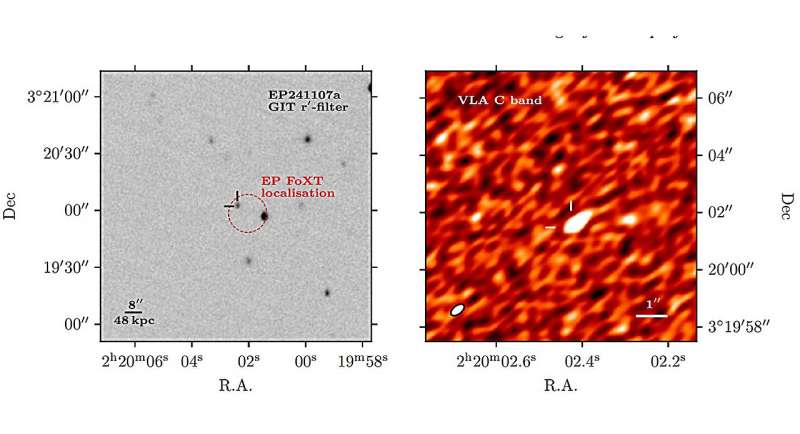Astronomers have made significant strides in understanding a fast X-ray transient, designated EP241107a, which is believed to originate from a gamma-ray burst (GRB). This finding comes after extensive multiwavelength observations conducted by a team led by Deepak Eappachen from the Indian Institute of Astrophysics. The research, published on November 4, 2025, on the arXiv preprint server, delves into the mysterious characteristics of this transient, first detected on November 7, 2024.
The transient was observed by the Wide-field X-ray Telescope (WXT) onboard the Einstein Probe, a Chinese space telescope launched in January 2024. Fast X-ray transients (FXTs) are notoriously challenging to detect due to their unpredictable occurrences and brief durations, lasting from a few hundred seconds to several hours. The nature of FXTs remains elusive, with potential origins including stellar flares, supernova shock breakouts, and long gamma-ray bursts.
Observations of EP241107a revealed an optical counterpart in the I c-band, measured at a magnitude of 17.85. Recognizing the need for further investigation, Eappachen and his team conducted follow-up observations using ground-based telescopes, including the GROWTH-India Telescope and Himalayan Chandra Telescope.
Key Findings from Multiwavelength Observations
The research team successfully detected a radio counterpart of EP241107a, with flux densities of approximately 232 μJy at 10 GHz and 207 μJy at 6 GHz. The spectroscopic redshift of the transient was established at 0.457. Notably, EP241107a exhibited an X-ray luminosity of about 3.4 quindecillion erg/s in the 0.5-4 keV band when first observed. This value surpassed the expected luminosities associated with typical supernova shock breakouts.
Approximately 60 minutes after the initial detection, the astronomers identified an X-ray afterglow with a luminosity of 0.012 quindecillion erg/s in the 0.5–10 keV band, which declined rapidly over time. The host galaxy of EP241107a was also examined, revealing a stellar mass of about two billion solar masses and a star formation rate estimated at 0.6 solar masses per year.
Implications for Understanding Gamma-Ray Bursts
The researchers compared the optical and radio light curves of EP241107a with those of other known transients, revealing that its properties align with those typical of gamma-ray bursts. They concluded, “We compared the radio and optical light curves of EP241107a with those of other transients and found that EP241107a is consistent with the parameter space occupied by GRB afterglows.”
Despite these findings, the authors noted that the absence of gamma-ray emission and the specific viewing geometry inferred from afterglow modeling suggest that EP241107a may represent an intrinsically faint gamma-ray burst. This research adds valuable insight into the origins of fast X-ray transients and their connection to more powerful cosmic events.
This study exemplifies the collaborative efforts in modern astronomy, revealing not only the complexities of these cosmic phenomena but also the advanced observational capabilities of current technology. The findings from this research highlight the ongoing quest to understand the universe’s most enigmatic occurrences.







































































